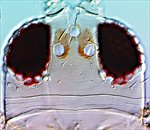
trifasciatus head
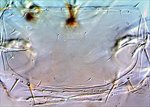
trifasciatus pronotum
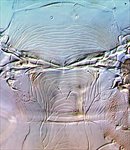
trifasciatus meso & metanota
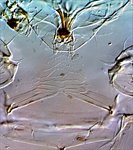
trifasciatus prosternum
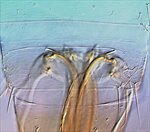
trifasciatus tergite VIII

trifasciatus sternite VII
Generic diagnosis
Female macropterous. Head wider than long; maxillary palps 3-segmented; eyes large, without pigmented facets; ocellar setae I absent, setae III not elongate; six pairs of small postocular setae. Antennae 8-segmented, segment I without paired dorso-apical setae, III and IV with elongate forked sense-cones, V–VI with some microtrichia on both surfaces. Pronotum wider than long, slightly concave near anterior angles; seven pairs of posteromarginal setae, S5 and S7 longest. Mesonotum with median pair of setae near posterior margin; campaniform sensilla present. Metanotum sculptured transversely; median pair of setae situated far from anterior margin; campaniform sensilla present. Fore wing narrow; costal vein with apical setae elongate, twice as long as preapical setae; first vein with long gap in setal row, seven basal and three distal setae; second vein with four setae; clavus with 5 veinal and 1 discal setae; posteromarginal fringe cilia wavy. Prosternal ferna scarcely divided medially; basantra membranous, with or without setae; prospinasternum broad, transverse. Mesosternum with sternopleural sutures reaching anterior margin; endofurca with or without spinula. Metasternal endofurca without spinula. Tarsi 2-segmented. Tergites without ctenidia or craspeda, campaniform sensilla present medially; tergite VIII with small granulated area around each spiracle; IX with two pairs campaniform sensilla, MD setae present; X with or without median split. Sternites II–VII without craspeda or discal setae; III–VII with three pairs of posteromarginal setae, II with two pairs; VII with all setae at posterior margin; laterotergites without discal setae.
Male similar to female; tergite IX with two pairs of short, stout, thorn-like setae, usually with small microtrichia between these setae; sternites without pore plates.
Biological data
Adults and larvae apparently feed on young leaves and very young fruits.
Distribution data
The natural distribution of this genus appears to extend from northern India south across southern Asia to The Philippines, but trifasciatus is more widely distributed. This species has presumably been dispersed through the horticultural trade, and is known from Florida, Hawaii and Australia. All four species recorded in China are from the south of this country.
Nomenclatural data
Danothrips Bhatti, 1971: 337. Type species Danothrips setifer Bhatti, 1971, by monotypy.
Eleven species are recognised in this genus (ThripsWiki, 2020), of which four are recorded from China:
sakimurai Chen, 1979: 418.
theivorus (Karny, 1921: 75). (Anaphothrips)
trifasciatus Sakimura, 1975: 125.
vicinus Chen, 1979: 417.
Relationship data
Thripidae sub-family Thripinae: this is a diverse group involving more than 230 genera. Species of this genus are similar in appearance to species of Chaetanaphothrips, but have the antero-lateral margins of the pronotum slightly concave, and moreover lack extensive plastron-like sculpture on tergite VIII anterior to the spiracles.
References
Li YJ, Xie YH & Zhang HR (2016) A new species of Danothrips from Southwestern China (Thysanoptera: Thripidae) Zootaxa, 4161 (1): 116–118.
ThripsWiki (2020) ThripsWiki - providing information on the World's thrips. <http://thrips.info/wiki/Main_Page>
Tyagi K, Singha D & Vikas Kumar (2017) Danothrips litseae sp.n. (Thysanoptera, Thripidae) from India on leaves of Litsea. Zootaxa 4269 (1): 137–140.